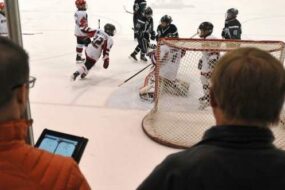
The Game Management Cycle – “3 Ways to Better Manage a Basketball Game & Give Your Team the Best Chance at Winning” 🡪 Pre-Game, Game-Day, and Post-Game Preparation and Evaluation
Dear fellow basketball coaches, I’m thrilled to explore today’s subject with you. Whether you come across this basketball coaching article at any time of the year, it’s crucial to contemplate how you and your team approach the game-day experience – from preparation to managing the actual game, and then analyzing the post-game information.
I firmly hold the belief that top-notch basketball programs adhere to a systematic approach throughout the entire “Game Management Cycle.” These programs maintain a consistent plan and structure irrespective of each game’s outcome. Additionally, they are the ones that showcase their peak performance when it truly counts – at the end of the season!
n the below basketball coaching article, I’m going to break up the cycle into three distinct phases:
- Pre-Game:
- Emphasis on Scouting for Both Self and Opponent.
- Game Day:
- Efficient Management of the Day.
- Continuous Evaluation and Adjustment During the Game.
- Post-Game:
- Comprehensive Review, Evaluation, and Charting of the Game.
- Facilitating Insights to Propel the Team Forward.
Pre-Game: Scouting, Personal, and Game Plan
When gearing up for a game, the approach to scouting becomes a pivotal factor, and coaches across different levels hold varying perspectives on this aspect. Some basketball programs invest extensive time and practices in studying their opponents, while others firmly believe in focusing solely on their own team, allocating minimal attention to the opposition.
In my experience at UNC and other successful programs like Weber State, Sheridan JC, and Northern State University, we maintained an 80:20 ratio. This means that leading up to a game, 80% of our time and energy were dedicated to our team, with approximately 20% allocated to scouting the opponent through practice and film analysis.
I genuinely believe that a significant advantage can be gained through thorough opponent scouting. Analyzing their key tendencies on both offense and defense, as well as understanding their personnel, provides a strategic edge. While some teams with exceptional talent or a unique play system may allocate 100% of their focus internally, for most, a balanced approach is essential.
Given the wealth of basketball tools and resources available to coaches today, such as Synergy, KenPom, basic stats, and collaboration with other teams facing common opponents, there’s no excuse not to study opponents. Utilizing online video cutting tools can save time, enabling coaches to effectively identify strengths to exploit and weaknesses to address.
Here’s how scouting is broken down for our staff and players at Northern Colorado:
1. Offensive Strategy: Unlocking Their Defense Coach Linder, our Head Coach, dedicates considerable time to film analysis, developing a comprehensive plan for our offensive approach. This involves strategies for challenging their ball/screen coverage, creating advantageous switches, and effectively countering their zone defense.
2. Defensive Tactics: Sets, Transition, Post Feeding, etc. Our Lead Scout collaborates with Coach Linder to compile crucial information, encompassing defensive schemes. Each assistant coach employs their unique approach, with my preference being a concise 1-page template covering all essential aspects, including sets, transition defense, and post feeding strategies.
Some of the areas that I will look to cover are:
- Major Keys
- Matchups
- Opponents Defense
- BLOB Defense
- B/S Defense
- Post Defense
- Zone Defense
- Press Defense
- Opponents Offense
- Jump Ball Arrangement
- End of First Half Play
- End of Clock
- After Timeout
- Primary and Secondary Transition
- Misc.
- Sets (in order by frequency used)
Personnel
This involves distributing a 2-page document to our players along with a video edit typically spanning 10-12 minutes. Both the sheet and the video edit are synchronized and encompass the following categories:
- Season Stats
- Conference Stats
- 3-5 Key Points on “His Game” and 3-5 Key Points on “How to Defend”
- Each opposing player is defined as either a PLAYER, SNIPER, or DRIVER
Scouting TIMING
Two days before the basketball game, which is often a limited timeframe, there might be minimal preparation for the opponent, and at times, no specific focus is given. However, we might cover a few key concepts or ideas on the court. These can include aspects such as the opposing team’s transition plays, strategies for guarding a high-level post player, and perhaps a few targeted basketball drills addressing their primary offensive tactics.
Following the practice session, we prefer to dedicate approximately 10-12 minutes to review live action from the opponent’s most recent game. This step aims to provide valuable insights to our players before delving into a more comprehensive analysis during the subsequent day’s practice. Our Head Coach and Lead Scout for the opponent actively pause the film, highlighting both system and personnel-related observations, enhancing our efficiency in preparation for the upcoming game.
On the day preceding the game, a pivotal practice session unfolds in anticipation of the upcoming match. The assistant coach overseeing the scouting responsibilities orchestrates a meeting with our scout team approximately one hour before practice. During this briefing, the coach delineates the plan for the day, encompassing a detailed breakdown of:
- BLOB’s (typically no more than 4)
- Ball-Screen Actions (3-4 Max)
- 3 Point Plays (3-4 Max)
- Favorite Actions (3-4 Max)
Throughout the practice session, we incorporate the aforementioned actions, but they are never executed collectively.
As an illustration, we might commence with the analysis of an opponent’s BLOBs, followed by incorporating some of our own basketball plays in a simulated manner. Subsequently, we transition to shooting drills before delving into their ball-screen actions, then proceed with additional basketball shooting drills before addressing the opponent’s 3pt plays. Our approach involves integrating small segments of the opponent’s game plan throughout the practice, avoiding prolonged focus on one aspect.
Post-basketball practice, we promptly move to the film room to review the personnel edit and distribute relevant paperwork. The film and video editing session with our team typically spans between 20 to 30 minutes.
Game-Day: Evaluations and Adjustments
Let’s breakdown the day of the game into the following areas:
- Prior to Game
- During Game
- Half-Time
Prior to Game
Game-day Practice/Shoot-Around:
- A 40-60 minute (max) practice occurs approximately 5 hours before tip-off, ensuring a pre-game meal 4 hours before the game.
- Unlike the day-before practice, the game-day session focuses on reviewing key concepts for both our team’s attack and the opponent.
- No live sessions on game-day; emphasis on reviewing concepts and getting in a significant number of shots.
- Optional individual work sessions (max 30 minutes) are available throughout the day, especially for home games.
Personnel Board:
- Players arrive 120-90 minutes before tip-off, with a whiteboard detailing the opponent’s personnel, categorized by number, name, player type (Sniper/Driver), and position.
- Another board features Coach Linder’s concise keys and ideas for pre-game talks during warm-ups, ensuring clarity and avoiding information overload.
Player Warm-Up:
- Players hit the court 60 minutes before tip-off for a 10-minute free shoot, dribble, or loosen-up session.
- A 3-minute dynamic stretch led by the athletic trainer at the 50-minute mark.
- Position-specific work with post players and guards, alternating at the 47:00 and 43:00 marks.
- 2-line layups at 39:00, followed by a brief return to the locker room for Coach Linder’s personnel review and key points discussion.
- Back on the court at 24:00 for a final warm-up sequence, including finishing and shooting drills.
- Coach-led sessions continue, alternating between post players and guards until the 7:00 mark.
- Brief talks by Coach Linder at the 7:00 and 3:00 marks before heading back out for the game.
During Game: (What we Chart)
Coaches frequently inquire about the specific elements we track during the game, especially considering variations in staff size at different levels. Basketball coaches must prioritize based on the available number of assistants for charting, tailoring their focus to what is essential for their particular circumstances.
These are the basic items that we chart at UNC:
Fundamentals: Fouls & Timeouts – Taylor Green, our Director of Basketball Operations (DOBO), oversees these essential yet critical aspects.
Opponent Plays – The Lead Scout diligently records play calls with the assistance of our DOBO, ensuring documentation for future reference within the current game and throughout the season.
Player Substitutions – Handling this responsibility at UNC and previously at Weber, I consistently display the current 5v5 matchups on a medium-sized whiteboard. Proper player alignment is paramount, eliminating any confusion.
“Kills” – Tracked by another Assistant, a “KILL” denotes three consecutive defensive stops, serving as a measurable goal for our team defense. At halftime, we review our current number of kills, aiming for four per half.
Paint Touches – We meticulously track the number of shots resulting from paint touches, such as 13 paint touches leading to 21 shots.
Game Day/Play Call Sheet – Coach Linder crafts a personalized play call sheet, keeping it readily available for reference during timeouts and dead-ball situations.
Fouling Strategy – The Lead Scout must discern who to foul and who to avoid fouling in late-game scenarios, strategically extending the game when necessary.
Half-Time
Coaches’ Halftime Session – Upon returning to the coach’s locker room during our 15-minute halftime break, we allocate 3-5 minutes to analyze the box score, examine our charts (highlighting Kills & Paint Touches), and reflect on on-court observations. It’s crucial to use this time judiciously, identifying key points for discussion with the team, including necessary adjustments before the commencement of the second half.
Player Briefing – Approximately 10 minutes before the second half, our staff enters the player locker room for a concise 5-minute discussion with the team. We swiftly recap the number of Kills, review essential stats (such as the number of 3-pointers conceded), gather player insights, and promptly return to the court for a brief warm-up in the final 5 minutes before the start of the second half.
Post-Game: Evaluation and Review
We will do three things as a staff once the basketball game is over to review that game and launch us forward into our upcoming practices and games. These areas would be:
- Stats Review
- Game Film Grading
- Film Review (Individual & Team)
Stats Review
Post-Game Statistical Analysis – Following each game, we delve into three primary sources of statistical information. Firstly, the traditional game box score remains a valuable tool in today’s basketball landscape. This concise sheet offers a swift overview of the game’s dynamics, providing insights at both team and individual player levels.
The second source comprises the updated cumulative season statistics, encompassing both overall performance and conference-specific metrics. Our sports information director promptly emails us these updates on the same night, allowing us to assess the impact of the game on our players and team through their season box scores.
The final component of our post-game statistical review involves analyzing our updated KenPom sheet. Subscribing to kenpom.com, we place significant trust in the advanced statistics it provides, available almost immediately after a game concludes. Over my five years as an assistant basketball coach at the D1 level, I have consistently valued understanding the intricacies of KenPom. In fact, we have structured a considerable portion of our system based on the specific areas we aim to excel in, as guided by KenPom’s rating system.
Game Film Grading
Immediately after the game concludes, our coaching staff, comprising the Head Coach, three Assistants, DOBO, and Assistant DOBO, gain instant access to the game film on our laptops. Subsequently, each of us assumes distinct responsibilities in terms of editing and evaluating the footage to prepare for sharing with our team the following day.
In terms of grading the film, our roles as assistants are:
Defensive Shot Chart/PPP Analysis – My responsibility involves meticulously tracking every shot attempted by the opponent, categorizing them based on points scored (1, 2, or 3). Post-film grading allows me to discern the nature of the opponent’s shots, assessing whether we successfully dictated their shot selection or if they achieved the shots they desired. Additionally, I calculate the Points Per Possession (PPP) for each category, contributing to our extensive database. Over three years of accumulated data, we’ve developed a comprehensive understanding of preferred and undesired opponent shot types.
Offensive Shot Chart/PPP Evaluation – Tasked with this role, our DOBO, Taylor Green, employs the same chart used for defensive analysis. However, he focuses on grading our team’s offensive shots. This information is particularly shared with Coach Linder as part of the review process for offensive production in each game.
Defensive Rebound Assessment – Coach DeWeese systematically evaluates defensive rebounds, assigning grades for our players’ performance on each shot. A grading system, denoted as plus or minus, gauges individual contributions in adhering to assigned responsibilities. By the game’s end, the objective is for each player and the team collectively to achieve a rebounding effort of 80% or higher. To earn a plus, players must fulfill their specific rebounding responsibilities based on their positioning on the floor.
Offensive Rebound Evaluation – Coach McGhee mirrors this grading process for offensive rebounds, assigning plus or minus grades to players based on their performance for each shot attempt. Players are evaluated on their adherence to roles, such as “Crash” Guys aggressively pursuing rebounds and reaching at least a 50-50 outcome, or “Get-Back” Guys sprinting back to at least half-court upon the shot’s release. The overarching goal remains an individual and team offensive rebounding efficiency of 80%.
Film Review (Individual & Team)
Concluding a basketball game typically involves a crucial step: film review. Given sufficient time between games, the team engages in editing with various categories, with Coach Linder taking charge of offensive analysis. The assistants, including myself, focus on preparing edits for Good Defense, Bad Defense, Rebounding Effort, Winning Plays, Losing Plays, and more.
On an individual level, each Assistant is assigned 3-4 players for additional film and skill work. At UNC, we categorize this responsibility into Guards, Wings, and Posts. My specific group is the wings. After a game, I use Sports-Code to create edits for each of my players based on their individual clips, usually ranging from 20 to 40 clips per game, depending on their playing time.
The following day, the players under my supervision undergo brief film sessions with me, ideally before our next practice. In approximately 30 minutes, we efficiently analyze personalized film, adhering to the program’s non-negotiable standard of having film ready for players after each game. This commitment contributes to continual improvement in our players’ basketball IQs, a reduction in mistakes, and a tendency to peak in performance as we progress through the season, often showcasing our best basketball in March.
3 Ways to Better Manage Basketball Games Conclusion
Establishing an effective system to address every facet of the Game Management Cycle is paramount. Each level of play presents unique challenges, such as varying staff sizes, technological constraints, additional responsibilities, and limited time. Having served as an Athletic Director at two different campuses while coaching at Sheridan College, I fully comprehend these challenges.
In my view, every basketball coach should invest time in evaluating how to optimize team preparation before a game, provide effective support during the game, and, perhaps most significantly, engage in post-game analysis with players for closure and forward momentum.
Basketball programs that adeptly navigate the Game Management Cycle are typically the ones that demonstrate consistency and extract the maximum potential from each team.







